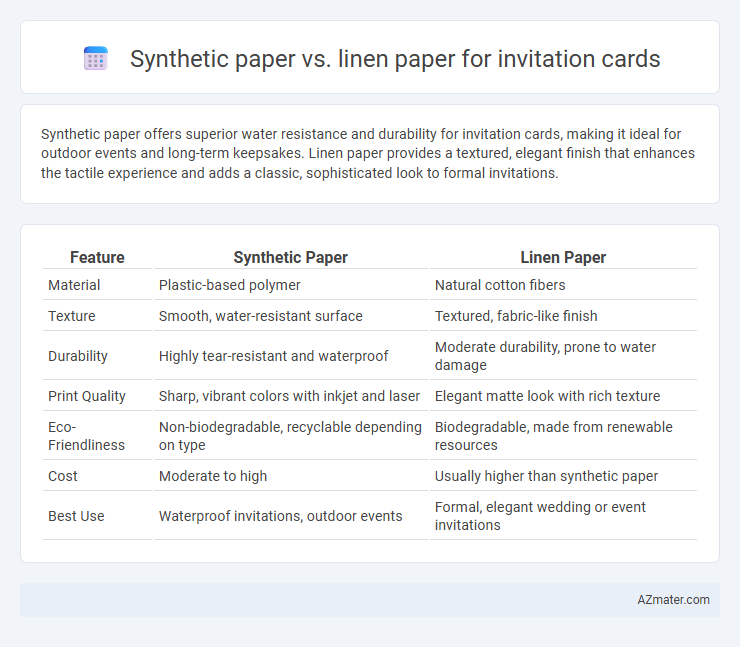Synthetic paper offers superior water resistance and durability for invitation cards, making it ideal for outdoor events and long-term keepsakes. Linen paper provides a textured, elegant finish that enhances the tactile experience and adds a classic, sophisticated look to formal invitations.
Table of Comparison
| Feature | Synthetic Paper | Linen Paper |
|---|---|---|
| Material | Plastic-based polymer | Natural cotton fibers |
| Texture | Smooth, water-resistant surface | Textured, fabric-like finish |
| Durability | Highly tear-resistant and waterproof | Moderate durability, prone to water damage |
| Print Quality | Sharp, vibrant colors with inkjet and laser | Elegant matte look with rich texture |
| Eco-Friendliness | Non-biodegradable, recyclable depending on type | Biodegradable, made from renewable resources |
| Cost | Moderate to high | Usually higher than synthetic paper |
| Best Use | Waterproof invitations, outdoor events | Formal, elegant wedding or event invitations |
Introduction to Synthetic and Linen Paper
Synthetic paper is a durable, water-resistant material made from polypropylene or polyethylene, offering tear-proof qualities and vibrant print clarity ideal for long-lasting invitation cards. Linen paper features a textured surface resembling woven fabric, providing an elegant, luxurious feel often used for formal invitations with a classic aesthetic. Both materials enhance invitation cards through unique tactile experiences, with synthetic paper emphasizing durability and linen paper focusing on sophisticated texture.
Key Differences Between Synthetic and Linen Paper
Synthetic paper offers superior durability, water resistance, and tear-proof qualities, making it ideal for invitation cards intended for outdoor or long-term use. Linen paper features a textured, fabric-like finish with a classic, elegant appearance, providing a tactile and sophisticated feel preferred for traditional or formal invitations. While synthetic paper excels in longevity and resilience, linen paper stands out for its aesthetic appeal and natural fiber texture.
Texture and Feel: Synthetic vs Linen Paper
Synthetic paper offers a smooth, waterproof surface with a slightly plastic feel that enhances durability and resists tearing, ideal for outdoor or high-handling invitations. Linen paper features an embossed, fabric-like texture that adds an elegant, tactile richness and traditional sophistication, perfect for formal or classic-themed invitations. The choice between synthetic and linen paper ultimately depends on the desired tactile experience and event ambiance, balancing durability with luxury.
Print Quality and Color Vibrancy
Synthetic paper offers superior print quality with sharp, vibrant colors due to its smooth, non-porous surface that prevents ink bleed and ensures consistent color reproduction. Linen paper provides a textured, elegant finish that diffuses ink slightly, resulting in softer color tones and a classic, tactile appeal. For invitations demanding bright, crisp visuals, synthetic paper excels, while linen paper suits designs favoring subtle color depth and sophisticated texture.
Durability and Water Resistance Comparison
Synthetic paper offers superior durability compared to linen paper, as it resists tearing, creasing, and general wear more effectively. Its waterproof properties ensure that invitation cards remain pristine even when exposed to moisture, whereas linen paper tends to absorb water, leading to potential damage and warping. Choosing synthetic paper enhances the longevity and resilience of invitations, especially for events where handling and environmental exposure are concerns.
Environmental Impact and Sustainability
Synthetic paper used for invitation cards offers durability and water resistance but is typically made from petrochemical products, which raises concerns about non-biodegradability and microplastic pollution. Linen paper, derived from flax plants, is biodegradable and often produced using fewer chemicals, making it a more sustainable option with a lower environmental footprint. Choosing linen paper supports eco-friendly practices through renewable resources and better end-of-life disposal options compared to synthetic alternatives.
Cost Comparison: Budget Considerations
Synthetic paper typically costs more than linen paper due to its durability and water-resistant properties, making it a premium choice for invitation cards that need longevity. Linen paper, with its textured finish and affordability, offers a budget-friendly option suitable for elegant invitations without a high price tag. Balancing cost against desired durability and aesthetic will guide the best paper selection for cost-effective invitation printing.
Design Versatility for Invitation Cards
Synthetic paper offers exceptional design versatility for invitation cards due to its smooth, waterproof surface that supports vibrant, high-resolution printing and intricate details. Linen paper features a textured finish that enhances tactile appeal and lends a classic, elegant look, ideal for formal events but may limit fine design elements. Choosing between synthetic and linen paper depends on whether the priority is durability and vivid color reproduction or a traditional, textured aesthetic for invitations.
Suitability for Different Event Types
Synthetic paper offers exceptional durability and water resistance, making it ideal for outdoor or casual event invitations such as beach weddings or garden parties. Linen paper, with its textured surface and elegant appearance, suits formal events like weddings, anniversaries, and corporate gatherings where a classic, sophisticated presentation is desired. Choosing between synthetic and linen paper depends on the event's tone and environment, ensuring the invitation reflects the occasion's formality and practical needs.
Choosing the Best Paper for Your Invitations
Synthetic paper offers durability, water resistance, and a smooth finish, making it ideal for invitations that require long-lasting quality and vibrant printing. Linen paper provides a classic, textured look with an elegant, tactile feel perfect for formal or vintage-style invitations. Selecting the best paper depends on event style, desired durability, and print quality to ensure the invitation leaves a memorable impression.

Infographic: Synthetic paper vs Linen paper for Invitation card
 azmater.com
azmater.com